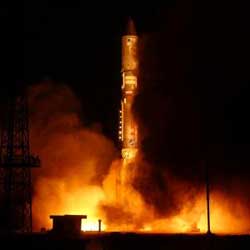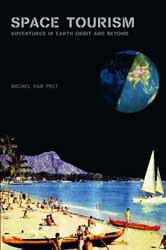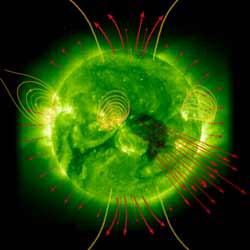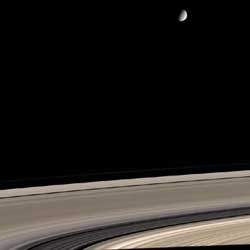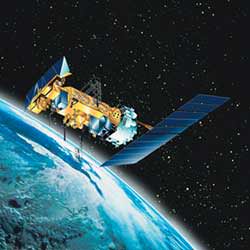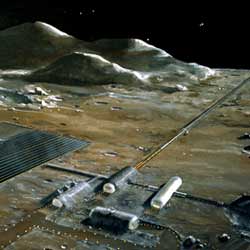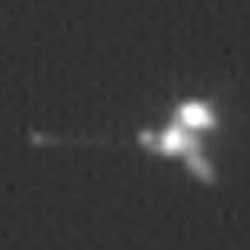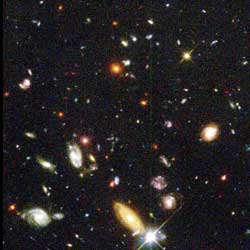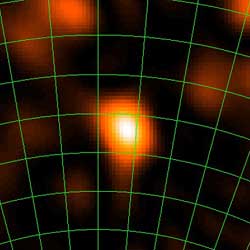
Low-frequency radio sky at the time of a cosmic ray hit. Image credit: MPIFR. Click to enlarge.
Using the LOPES experiment, a prototype of the new high-tech radio telescope LOFAR to detect ultra-high energy cosmic ray particles, a group of astrophysicists, in collaboration of Max-Planck-Gesellschaft and Helmholtz-Gemeinschaft, has recorded the brightest and fastest radio blasts ever seen on the sky. The blasts, whose detection are reported in this week’s issue of the journal Nature, are dramatic flashes of radio light that appear more than 1000 times brighter than the sun and almost a million times faster than normal lightning. For a very short moment these flashes – which had gone largely unnoticed so far – become the brightest light on the sky with a diameter twice the size of the moon.
The experiment showed that the radio flashes are produced in the Earth atmosphere, caused by the impact of the most energetic particles produced in the cosmos. These particles are called ultra-high energy cosmic rays and their origin is an ongoing puzzle. The astrophysicists now hope that their finding will shed new light on the mystery of these particles.
The scientists used an array of radio antennas and the large array of particle detectors of the KASCADE-Grande experiment at Forschungszentrum Karlsruhe. They showed that whenever a very energetic cosmic particle hit the Earth atmosphere a corresponding radio pulse was recorded from the direction of the incoming particle. Using imaging techniques from radio astronomy the group even produced digital film sequences of these events, yielding the fastest movies ever produced in radio astronomy. The particle detectors provided them with basic information about the incoming cosmic rays.
The researchers were able to show that the strength of the emitted radio signal was a direct measure of the cosmic ray energy. “It is amazing that with simple FM radio antennas we can measure the energy of particles coming from the cosmos” says Prof. Heino Falcke from the Netherlands Foundation for Research in Astronomy (ASTRON) who is the spokesperson of the LOPES collaboration. “If we had sensitive radio eyes, we would see the sky sparkle with radio flashes”, he adds.
The scientists used pairs of antennas similar to those used in ordinary FM radio receivers. “The main difference to normal radios is the digital electronics and the broad-band receivers, which allow us to listen to many frequencies at once”, explains Dipl. Phys. Andreas Horneffer, a graduate student of the University of Bonn and the International Max-Planck Research School (IMPRS), who installed the antennas as part of his PhD project.
In principle some of the detected radio flashes are in fact strong enough to wipe out conventional radio or TV reception for a short time. To demonstrate this effect the group has converted their radio reception of a cosmic ray event into a sound track (see below). However, since the flashes only last for some 20-30 nanoseconds and bright signals happen only once a day, they would be hardly recognisable in everyday life.
The experiment also showed that the radio emission varied in strength relative to the orientation of the Earth magnetic field. This and other results verified basic predictions that had been made in theoretical calculations earlier by Prof. Falcke and his former PhD student Tim Huege, as well as by calculations of Prof. Peter Gorham from the University of Hawaii.
Cosmic ray particles constantly bombard the earth causing little explosions of elementary particles which form a beam of matter and anti-matter particles rushing through the atmosphere. The lightest charged particles, electrons and positrons, in this beam will be deflected by the geomagnetic field of the Earth which causes them to emit radio emission. This type of radiation is well known from particle accelerators on Earth and is called synchrotron radiation. In analogy, the astrophysicists now speak of “geosynchrotron” radiation due to the interaction with the Earth magnetic field.
The radio flashes were detected by the LOPES antennas installed at the KASCADE-Grande cosmic ray air shower experiment at Forschungszentrum Karlsruhe, Germany. KASCADE-Grande is a leading experiment for measuring cosmic rays. “This shows the strength of having a major astroparticle physics experiment directly in our neighbourhood – this gave us the flexibility to also explore unusual ideas as this one” says Dr. Andreas Haungs, spokesperson of KASCADE-Grande.
The radio telescope LOPES (LOFAR Prototype Experimental Station) uses prototype antennas of the largest radio telescope of the world, LOFAR, to be built after 2006 in the Netherlands and parts of Germany. LOFAR has a radical new design, combining a multitude of cheap low-frequency antennas which collect the radio signals from the entire sky at once. Connected by high-speed internet a supercomputer then has the ability to detect unusual signals and make images of interesting regions on the sky without moving any mechanical parts. “LOPES achieved the first major scientific results of the LOFAR project already in the development phase. This makes us confident that LOFAR will indeed be as revolutionary as we had hoped it will be.” explains Prof. Harvey Butcher, director of the Netherlands Foundation for Research in Astronomy (ASTRON) in Dwingeloo, The Netherlands, where LOFAR is currently being developed.
“This is indeed an unusual combination, where nuclear physicists and radio astronomers work together to create a unique and highly original astroparticle physics experiment”, states Dr. Anton Zensus, director at the Max-Planck-Institut f?r Radioastronomie (MPIfR) in Bonn. “It paves the way for new detection mechanisms in particle physics as well as demonstrating the breathtaking capabilities of the next generation telescopes such as LOFAR and later the Square Kilometer Array (SKA). Suddenly major international experiments in different research areas come together”
As a next step the astrophysicists want to use the upcoming LOFAR array in the Netherlands and Germany for radio astronomy and cosmic ray research. Test are under way to integrate radio antenna into the Pierre Auger Observatory for cosmic rays in Argentina and possibly later in the second Auger Observatory in the Northern hemisphere. “This may be a major breakthrough in detection technology. We hope to use this novel technique for detecting and understanding the nature of the highest energy cosmic rays and also to detect ultra-high energy neutrinos from the cosmos”, says Prof. Johannes Bl?mer, Astroparticle Physics programme director of the Helmholtz Association and at Forschungszentrum Karlsruhe.
The detection has been confirmed in part by a French group using the large radio telescope of the Paris observatory at Nan?ay. Historically, work on radio emission from cosmic rays was first done in the late 1960ies with the first claims of detections. However, no useful information could be extracted with the technology of these days, and the work ceased quickly. The main shortcomings were the lack of imaging capabilities (now implemented by software), the low time resolution, and the lack of a well-calibrated particle detector array. All of this has been overcome with the LOPES experiment.
Original Source: MPI News Release
